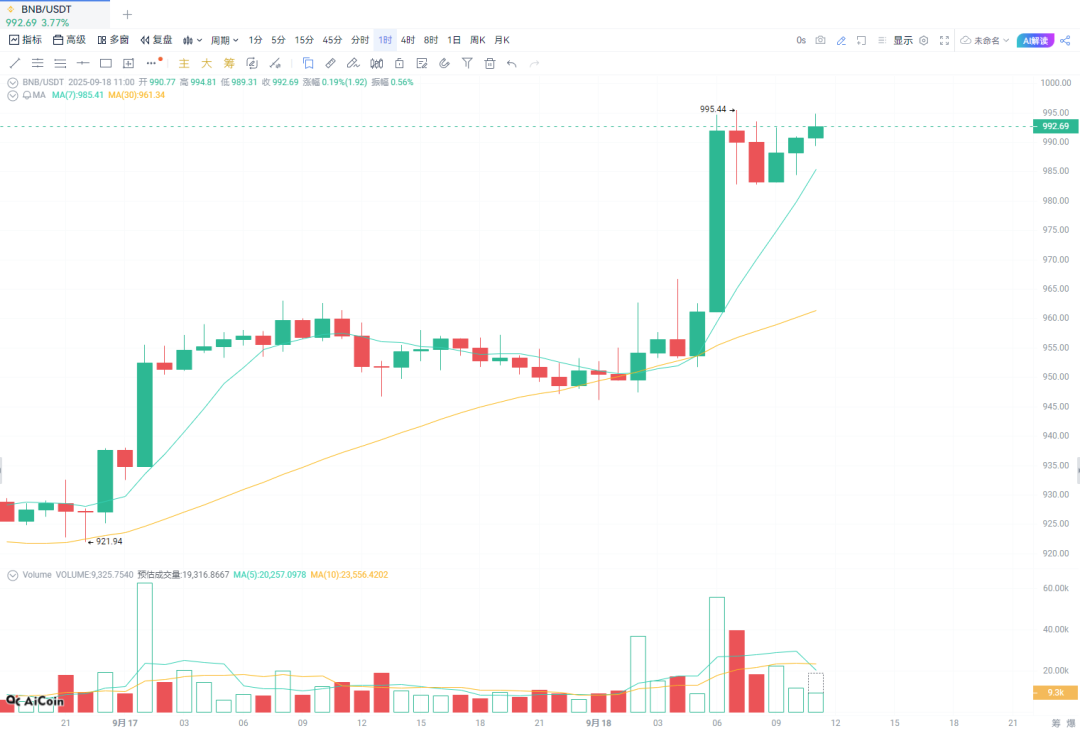81175
On the morning of September 18, the price of Binance’s native token BNB once hit a record high of $995.44, soaring more than 3% from the previous day, and its market value easily exceeded the $138.4 billion mark. This is not a blind speculation carnival, but is caused by the multiple combined forces of supply contraction, ecological expansion and institutional entry.  Deflation model: the iron law of supply created by the burning mechanism According to BNB Chain official data, more than 60 million BNB have been burned since 2025, compressing the circulation from about 145 million at the beginning of the year to the current 139.18 million. This number did not come out of thin air: the 32nd quarterly burn event of the third quarter was completed in July, permanently destroying 1.579 million BNB, worth approximately $950 million. The amount burned is dynamically adjusted based on BNB price and trading volume - the higher the price, the more burned, creating a self-reinforcing deflationary cycle. Currently, the circulating supply of BNB has hit a 20-month low of 139.187 million pieces, a decrease of nearly 20% compared with the same period last year. Picture this: when market sentiment turns positive, each purchase under fixed supply is like squeezing an increasingly narrowing pipe. In the first half of 2025, BNB’s market capitalization/supply ratio (MVRV) has risen to near historical highs, indicating that the average profitability of holders is as high as 150%. The Federal Reserve’s September meeting confirmed an interest rate cut of 25 basis points, and the deflationary pressure on BNB will further be converted into price rocket fuel. Critics question its reliance on the centralized elements of the Binance exchange - the burned funds mainly come from platform fees, and any regulatory storm may interrupt this chain. Data from 2025 refutes this concern: BNB’s burn execution rate remains above 99% even against the backdrop of tightening global crypto regulations. More importantly, BNB Chain’s Lorentz/Maxwell hard fork upgrade has reduced gas fees by 95% to an average of US$0.01 per transaction. This not only lowers the threshold for use, but also indirectly improves burning efficiency, because more transactions mean more fees return to the burning pool. The deep value of deflation lies in its promise to long-term holders. In a market filled with unlimited issuance of stablecoins and meme coins, BNB’s “hard cap” is like an iron gate, blocking the risk of dilution. The burn report in July 2025 shows that the total value burned has exceeded 20 billion US dollars, which is equivalent to erasing nearly 40% of the initial total supply. For institutional investors, this is a quantifiable “scarcity premium” – similar to the limited mining of gold, but in code that never expires. Currently, BNB’s daily active addresses have soared to 1.56 million, setting a new high in 2025. When the supply curve curves downward and the demand curve curves upward, the logic of price becomes obvious: $1,000 is not the end point, but the next milestone. Ecological prosperity: the flood of demand under the dApp craze If deflation is BNB’s “supply heart”, then BNB Chain’s ecological expansion is its “demand lungs”. In the third quarter of 2025, this Layer-1 network transformed from a DeFi fortress into a full-stack Web3 infrastructure at an astonishing speed. The number of dApps exceeded the 5,000 mark, and the transaction volume on the chain increased by 19% month-on-month. BNB Chain’s TVL (Total Locked Value) has reached US$7.75 billion, hitting a 3.5-year high. This is due to the leadership of native DEXs such as PancakeSwap: the protocol’s monthly transaction volume reached 188 billion US dollars, ranking first in the entire chain. Daily active users (DAAs) soared to 4.2 million, weekly transactions reached 85 million, and the median gas fee was only $0.0085. The Q3 report shows that BNB Chain’s cross-chain bridging activities increased by 41%, and the overall market share of DeFi TVL increased to 18% from 12% in the same period last year. The prosperity of the ecosystem stems from the blooming of multi-dimensional application scenarios. DeFi is still the mainstay, but the gaming and RWA (real world assets) sectors have suddenly emerged. In 2025, the number of game dApp users on BNB Chain will exceed 100 million, contributing 30% of the on-chain traffic. At the same time, RWA projects such as tokenized bonds and real estate funds have attracted more than US$1 billion in capital inflows. These applications, without exception, require BNB as gas fee "fuel" - each transaction reinforces the organic demand for the token. This wave of growth is not due to luck, but the result of strategic layout. BNB Chain’s five-year celebration report highlights that the total number of unique addresses has exceeded 615 million, and the project developer community has expanded to 5,000+. Compared with Ethereum’s high gas fees (average $0.5/transaction), BNB’s low-cost advantage is as precise as a scalpel, cutting away users’ hesitation. In the first half of 2025, daily transaction volume jumped from 4.1 million to 9.9 million, proving the network’s “economies of scale” effect. Although BNB Chain is decentralized, the shadow of Binance still lingers. Regulators may view it as an “exchange chain” and impose additional scrutiny. But the data is there: in Q3 of 2025, BNB Chain’s DeFi transaction volume has exceeded the sum of Ethereum and Solana. This flood of demand is transforming BNB from a "transaction fee token" into a "network currency", and its price elasticity is amplified. Analysts predict that if TVL exceeds 10 billion by the end of the year, BNB's gas fee consumption will push up demand pressure by an additional 10%-15%. Institutional interest: RWA alliance ignites market sentiment On September 10, 2025, the announcement of Binance’s RWA cooperation with Franklin Templeton instantly pushed BNB to a new high of $907. This traditional giant, which manages more than US$1.5 trillion in assets, will join forces with Binance to develop compliant tokenized securities products, which are expected to be launched by the end of the year. The impact of the cooperation is immediate: the RWA market will grow by 107% in 2025, exceeding US$12.35 billion. As a bridge asset, BNB directly benefited - within 24 hours after the announcement, the price surged 29%, and the cumulative increase during the year reached 75%. Franklin’s entry not only injects liquidity, but also enhances BNB’s “compliance halo”. Previously, institutions such as CEA Industries and Nano Labs had allocated $2.25 billion to BNB positions. Meanwhile, sentiment was high in futures and derivatives markets. The 24-hour trading volume of the BNB perpetual contract reached US$1.67 billion, and the open interest (OI) remained stable at US$1.65 billion. Full-year OI increased 14% to $3.1 billion. The long-short ratio shows that institutional bulls dominate and the leverage ratio rises modestly. This reflects the market’s confidence in BNB: not just speculation, but allocation based on fundamentals. Institutional interests are not charitable. Franklin chose BNB because its on-chain RWA infrastructure has matured - in 2025, BNB Chain processed more than 20% of global tokenized asset transactions. But be aware that geopolitics or SEC scrutiny could reverse sentiment. Looking back on the history of BNB: November 2017: Released, priced at $1 Early 2018: BNB price exceeded $10, becoming one of the most impressive performing crypto assets at the time February 2021: Crypto Bull Run, Breaking Above $100 September 2025: Approaching $1,000 How much more can BNB rise in the future? There are some predictions on the market for reference: 2025: In an optimistic scenario, BNB price could reach $1,000-$1,200 2030: With the popularity and application of blockchain technology, BNB price may challenge $2,800  |